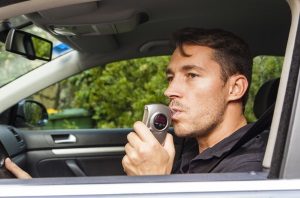Legally Reviewed By:
Brian P. Gabriel, Esquire
 The Intoxilyzer 8000 is the breathalyzer machine approved for evidentiary use by the State of Florida. It is a highly advanced but fallible piece of equipment. The machine tests breath alcohol concentration using infrared spectroscopy. Light passes through the breath sample of the DUI suspect. Any alcohol molecules in the suspect’s breath absorb radiation from the light. The radiation that was emitted is compared with the radiation absorbed. The difference is what is measured to produce a result. This result appears as grams of alcohol per 100 milliliters of blood. The legal limit is 0.08, or eight grams of alcohol per 100 milliliters of blood.
The Intoxilyzer 8000 is the breathalyzer machine approved for evidentiary use by the State of Florida. It is a highly advanced but fallible piece of equipment. The machine tests breath alcohol concentration using infrared spectroscopy. Light passes through the breath sample of the DUI suspect. Any alcohol molecules in the suspect’s breath absorb radiation from the light. The radiation that was emitted is compared with the radiation absorbed. The difference is what is measured to produce a result. This result appears as grams of alcohol per 100 milliliters of blood. The legal limit is 0.08, or eight grams of alcohol per 100 milliliters of blood.
Lung Alcohol
In BAC tests, the blood test is considered the most accurate of all, but it is also the most invasive. A breath test with the I-8000 is the standard noninvasive method.
What the Intoxilyzer 8000 (I-8000) is supposed to measure is the test subject’s deep lung air to determine an accurate breath alcohol concentration (BrAC). Deep lung air, or alveoli air, is supposedly in equilibrium with the subject’s blood. This belief is due to the fact that one’s lungs are made up of 300 million air sacs called “alveoli.” Each of these is surrounded by blood vessels so small that oxygen and carbon dioxide can freely pass between the blood and the air in the sacs. For this reason, BrAC is supposed to closely align with one’s blood alcohol concentration, or BAC.
All too often, the I-8000 accidentally picks up residual mouth alcohol instead of the alcohol that is deep inside one’s lungs. This flaw is responsible for thousands of inaccurate readings across the country.
Residual Mouth Alcohol
If any alcohol is consumed immediately before the test, there is a high possibility that the machine will read both lung air and mouth alcohol. Residual mouth alcohol, frequently referred to as simply “mouth alcohol,” is the alcohol that stays in one’s mouth after drinking alcohol. For the purposes of challenging a breath alcohol test’s results, this alcohol can be any alcohol that did not directly come from one’s lungs.
A reading based on mouth alcohol can occur from several situations. If a DUI suspect belches, hiccups, burps, or vomits, the alcohol from the gas or fluids can cause a false high reading. Alcohol from these sources is alcohol that is reintroduced into the airways from the stomach or air passages. Alcohol that actually stays in one’s mouth can come from the simple act of using mouthwash prior to a test, or even using cough syrup or cough drops that contain menthol. Even a new mouth piercing can cause the Intoxilyzer to show a higher alcohol concentration in the air exhaled than the concentration present in the alveoli air.
Required Observation Period
Because it is so easy to detect mouth alcohol, there is a required observation period in all jurisdictions that must be conducted prior to administering a breath test. By Florida law, this period must last 20 minutes. During that time, it is expected that any residual alcohol will have dissipated. If the suspect burps or hiccups during that time, or so much as chews gum, it must be started over for another 20 minutes until there is a clean 20 minutes of regular breathing. The suspect’s mouth is also checked for foreign objects before he or she is allowed to blow into the machine.
Several things sometimes go wrong when administering a DUI breath test. In addition to technical errors, there are operational errors that can take place. Not only do police officers have to be certified in conducting the tests, they must do so properly. The residual mouth alcohol defense is the top defense against the breathalyzer test results.
At The Law Offices of Gabriel & Gabriel, attorney Brian Gabriel leads Palm Beach County DUI defense with over 30 years of experience. He leaves no stone unturned when researching and developing your case. Call 561-622-5575 today for a free DUI consultation or complete a contact form today.



